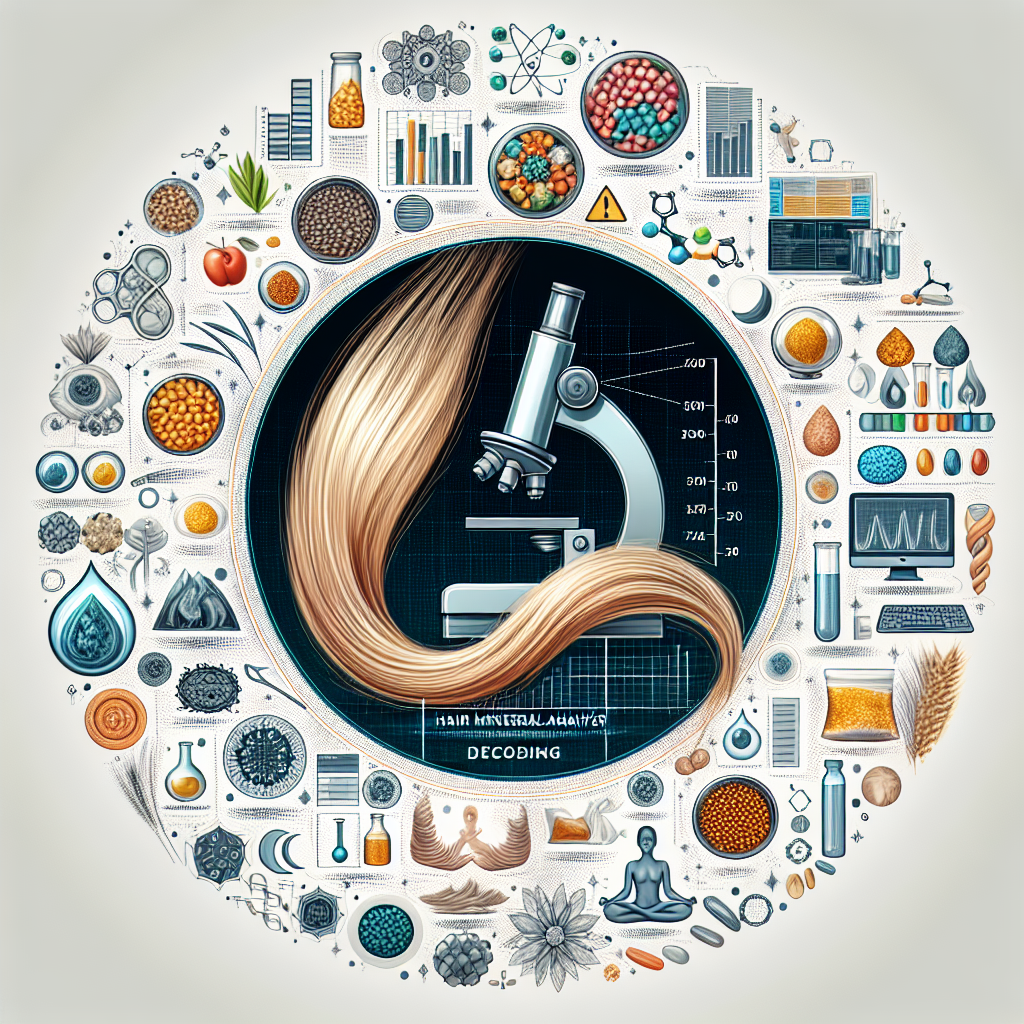Decoding Hair Mineral Analysis for Holistic Health

Discover the secrets of your health through Decoding Hair Mineral Analysis for Holistic Health. Uncover the hidden messages in your hair and take a step towards a healthier, more vibrant you. Start your journey here.
Understanding the Role of Hair Mineral Analysis in Holistic Health
Hair mineral analysis is a diagnostic tool that has been gaining traction in the field of holistic health. It is a non-invasive test that measures the levels and comparative ratios of nutrients and toxic metals found in hair. This article aims to decode the role of hair mineral analysis in holistic health, shedding light on its significance and potential benefits.
Hair mineral analysis is premised on the idea that our hair, like a historical record, captures a unique story of our overall health and wellbeing. As hair grows, it absorbs and stores vital information about the body’s metabolic activity, nutritional deficiencies, and exposure to toxins. This information, when analyzed, can provide a comprehensive picture of an individual’s health status, offering insights that go beyond the scope of conventional blood and urine tests.
The process of hair mineral analysis begins with the collection of a small sample of hair, usually from the back of the scalp. The sample is then sent to a laboratory where it undergoes a series of tests to determine the levels of various minerals and toxic metals. The results are then interpreted by a trained professional who can provide personalized recommendations for dietary changes, supplements, and lifestyle modifications.
One of the key benefits of hair mineral analysis is its ability to detect mineral imbalances and heavy metal toxicity. Minerals are essential for various bodily functions, including enzyme production, bone health, and nerve function. An imbalance in these minerals can lead to a host of health issues, from fatigue and poor concentration to more serious conditions like heart disease and diabetes. Hair mineral analysis can identify these imbalances early on, allowing for timely intervention and prevention.
Similarly, exposure to toxic metals is a growing concern in today’s industrialized world. These toxins can accumulate in the body over time, leading to a range of health problems, including neurological disorders, immune system dysfunction, and chronic disease. Hair mineral analysis can detect the presence of these toxic metals, providing a valuable tool for detoxification and overall health improvement.
Another advantage of hair mineral analysis is its potential for personalized health care. By providing a detailed snapshot of an individual’s nutritional status and toxic load, it allows for targeted interventions that are tailored to the individual’s unique needs. This personalized approach aligns with the principles of holistic health, which emphasize the importance of treating the whole person, not just the symptoms.
Despite its potential benefits, it’s important to note that hair mineral analysis should not be used as a standalone diagnostic tool. It should be used in conjunction with other tests and assessments, and the results should be interpreted by a trained professional. Furthermore, while hair mineral analysis can provide valuable insights into an individual’s health, it is not a substitute for a balanced diet, regular exercise, and a healthy lifestyle.
In conclusion, hair mineral analysis is a promising tool in the field of holistic health. It offers a non-invasive, comprehensive, and personalized approach to health assessment, with the potential to detect mineral imbalances and toxic metal exposure early on. As we continue to explore and understand its capabilities, it’s clear that hair mineral analysis has a significant role to play in promoting holistic health and wellbeing.
Decoding the Science Behind Hair Mineral Analysis for Optimal Wellness

Hair mineral analysis is a fascinating scientific tool that has been gaining traction in the field of holistic health. This technique involves the examination of a small hair sample to determine the levels of essential minerals and toxic metals in the body. The results of this analysis can provide a wealth of information about an individual’s overall health and wellness, offering a unique perspective on the body’s internal environment.
The science behind hair mineral analysis is rooted in the understanding that our hair, like every other part of our body, is nourished by the blood, lymph, and extracellular fluids. As these fluids circulate, they deposit various minerals and metals into our hair. Over time, these deposits form a record of our nutritional status and exposure to toxins.
Hair mineral analysis is a non-invasive procedure that can reveal a lot about our internal health. The process begins with the collection of a hair sample, typically from the back of the head. This sample is then sent to a laboratory where it is washed and prepared for analysis. The hair is then subjected to various tests that can detect the presence and concentration of different minerals and metals.
The results of a hair mineral analysis can provide a snapshot of an individual’s metabolic rate, energy levels, sugar and carbohydrate tolerance, immune system health, and adrenal and thyroid gland function. It can also reveal the presence of toxic metals such as lead, mercury, and arsenic, which can have detrimental effects on health.
One of the key benefits of hair mineral analysis is its ability to detect imbalances and deficiencies that may not be apparent through other diagnostic methods. For instance, a person may have normal blood levels of a certain mineral, but a hair mineral analysis could reveal a deficiency in the body’s tissues. This is because hair mineral analysis measures the levels of minerals and metals in the tissues, rather than in the blood or urine.
Moreover, hair mineral analysis can provide valuable insights into the body’s response to stress. Chronic stress can lead to mineral imbalances and deficiencies, which can in turn affect various aspects of health. By identifying these imbalances, hair mineral analysis can help guide the development of personalized treatment plans aimed at restoring balance and promoting optimal health.
However, it’s important to note that hair mineral analysis should not be used as a standalone diagnostic tool. While it can provide valuable insights into an individual’s health, it should be used in conjunction with other diagnostic methods and medical advice.
In conclusion, hair mineral analysis is a powerful tool in the field of holistic health. By providing a snapshot of an individual’s internal environment, it can help identify imbalances and deficiencies that may be impacting health. With this information, healthcare practitioners can develop personalized treatment plans that address these issues and promote optimal wellness. As our understanding of the science behind hair mineral analysis continues to grow, so too does its potential to contribute to our pursuit of holistic health.
The Impact of Hair Mineral Analysis on Holistic Health Practices
Hair mineral analysis (HMA) has emerged as a significant tool in the realm of holistic health practices, offering a wealth of information about an individual’s nutritional status, metabolic activity, and potential exposure to environmental toxins. This non-invasive diagnostic technique involves the analysis of a small sample of hair to determine the levels of essential and toxic elements present. The results of this analysis can provide valuable insights into an individual’s overall health and wellbeing, thereby enabling healthcare practitioners to devise personalized treatment plans that address the root causes of health issues rather than merely alleviating symptoms.
The human body is a complex system, and its optimal functioning depends on a delicate balance of various minerals. These minerals play crucial roles in numerous physiological processes, including enzyme function, energy production, and the maintenance of the immune system. However, imbalances in mineral levels can lead to a host of health problems. For instance, an excess of toxic metals such as lead or mercury can cause neurological issues, while deficiencies in essential minerals like magnesium or zinc can impair immune function and energy production.
Hair mineral analysis can detect these imbalances, providing a comprehensive picture of an individual’s mineral status. Unlike blood tests, which only provide a snapshot of the body’s mineral levels at a specific point in time, hair mineral analysis reflects long-term mineral accumulation, offering a more accurate representation of the body’s overall mineral status.
Moreover, hair mineral analysis can also reveal the presence of toxic elements that the body has been exposed to over time. Environmental toxins are ubiquitous in today’s world, and chronic exposure to these harmful substances can have detrimental effects on health. By identifying these toxins, hair mineral analysis can help healthcare practitioners develop detoxification strategies to eliminate these harmful substances from the body.
The results of hair mineral analysis can serve as a roadmap for holistic health practitioners, guiding them in their efforts to restore balance and promote optimal health. Based on these results, practitioners can recommend dietary modifications, nutritional supplements, and lifestyle changes tailored to the individual’s unique needs. For instance, if the analysis reveals a deficiency in magnesium, a common mineral involved in over 300 enzymatic reactions in the body, the practitioner might suggest increasing dietary intake of magnesium-rich foods or taking a magnesium supplement.
Furthermore, hair mineral analysis can also be used as a preventative tool, helping to identify potential health issues before they manifest as physical symptoms. This proactive approach aligns with the holistic health philosophy of promoting wellness rather than merely treating disease.
In conclusion, hair mineral analysis is a powerful tool in the field of holistic health, providing valuable insights into an individual’s nutritional status, metabolic activity, and exposure to environmental toxins. By identifying imbalances and toxicities, this diagnostic technique enables healthcare practitioners to devise personalized treatment plans that address the root causes of health issues. Moreover, it promotes a proactive approach to health, helping to prevent disease and promote optimal wellness. As such, hair mineral analysis is an invaluable asset in the quest for holistic health and wellbeing.